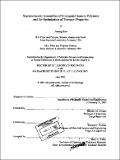Supramolecular assemblies of conjugated sensory polymers and the optimization of transport properties
Author(s)
Kim, Jinsang, 1969-
DownloadFull printable version (12.76Mb)
Other Contributors
Massachusetts Institute of Technology. Dept. of Materials Science and Engineering.
Advisor
Timothy M. Swager and Michael F. Rubner.
Terms of use
Metadata
Show full item recordAbstract
(cont.) The vectorial energy transfer design of sensory films to harvest and direct energy to the surface detection layer toward ultimate signal amplification has been discussed. Third, the role of chemical structure of a sensory polymer in the selectivity of a conjugated polymer-based fluorescent sensor has been examined. In two different sensory systems for the detection of potassium ions and a nitroaromatic explosive TNT, respectively, key chemical design parameters governing their selectivity have been rationalized. Finally, the combination of the conclusions of this thesis provided an idealized structure of a fluorescent conjugated polymer-based sensory film with optimized sensitivity and selectivity. A sensor is one of the many important applications of conjugated polymers. Poly(p-phenylene ethynylene)s (PPEs) have been studied for fluorescence-based sensor applications. The chemical structure and nano-structure of a polymer in the solid-state are two critical parameters that determine sensitivity and selectivity of a conjugated polymer-based sensor. In this thesis, both parameters have been systematically investigated. First, the Langmuir-Blodgett method was used to control the nano-structure of PPEs in the solid-state. Rational design of surfactant PPEs made it possible to control the conformation of a single polymer strand and interpolymer spatial arrangement at the air-water interface. In situ UV-Vis and fluorescence spectroscopy on the Langmuir film in controlled nano-structures revealed the effects of conformation and spatial arrangement of conjugated polymers on their intrinsic optical properties. Since the controlled structure of a monolayer at the air-water interface can be transferred to a solid substrate, structurally well-defined multilayer LB films of PPEs with confined optical properties were fabricated. This made it possible to study the role of interpolymer aggregation in the photophysical properties of conjugated polymer films. The results provided a general design principle to make a highly emissive conjugated polymer film. Second, an ideal thickness of a sensory film for optimizing sensitivity was determined by experimental and theoretical analysis of energy transport phenomena in multilayer PPE films.
Description
Thesis (Ph.D.)--Massachusetts Institute of Technology, Dept. of Materials Science and Engineering, 2001. Includes bibliographical references.
Date issued
2001Department
Massachusetts Institute of Technology. Department of Materials Science and EngineeringPublisher
Massachusetts Institute of Technology
Keywords
Materials Science and Engineering.